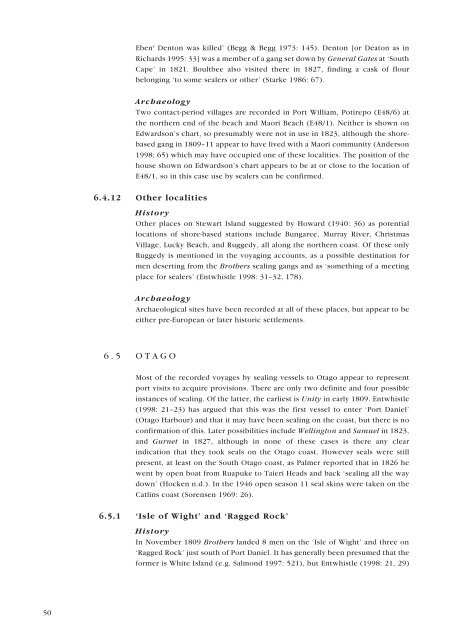The New Zealand Sealing Industry - Department of Conservation
The New Zealand Sealing Industry - Department of Conservation
The New Zealand Sealing Industry - Department of Conservation
You also want an ePaper? Increase the reach of your titles
YUMPU automatically turns print PDFs into web optimized ePapers that Google loves.
Eben r Denton was killed’ (Begg & Begg 1973: 145). Denton [or Deaton as in<br />
Richards 1995: 33] was a member <strong>of</strong> a gang set down by General Gates at ‘South<br />
Cape’ in 1821. Boultbee also visited there in 1827, finding a cask <strong>of</strong> flour<br />
belonging ‘to some sealers or other’ (Starke 1986: 67).<br />
Archaeology<br />
Two contact-period villages are recorded in Port William, Potirepo (E48/6) at<br />
the northern end <strong>of</strong> the beach and Maori Beach (E48/1). Neither is shown on<br />
Edwardson’s chart, so presumably were not in use in 1823, although the shorebased<br />
gang in 1809–11 appear to have lived with a Maori community (Anderson<br />
1998: 65) which may have occupied one <strong>of</strong> these localities. <strong>The</strong> position <strong>of</strong> the<br />
house shown on Edwardson’s chart appears to be at or close to the location <strong>of</strong><br />
E48/1, so in this case use by sealers can be confirmed.<br />
6.4.12 Other localities<br />
History<br />
Other places on Stewart Island suggested by Howard (1940: 36) as potential<br />
locations <strong>of</strong> shore-based stations include Bungaree, Murray River, Christmas<br />
Village, Lucky Beach, and Ruggedy, all along the northern coast. Of these only<br />
Ruggedy is mentioned in the voyaging accounts, as a possible destination for<br />
men deserting from the Brothers sealing gangs and as ‘something <strong>of</strong> a meeting<br />
place for sealers’ (Entwhistle 1998: 31–32, 178).<br />
Archaeology<br />
Archaeological sites have been recorded at all <strong>of</strong> these places, but appear to be<br />
either pre-European or later historic settlements.<br />
6.5 OTAGO<br />
Most <strong>of</strong> the recorded voyages by sealing vessels to Otago appear to represent<br />
port visits to acquire provisions. <strong>The</strong>re are only two definite and four possible<br />
instances <strong>of</strong> sealing. Of the latter, the earliest is Unity in early 1809. Entwhistle<br />
(1998: 21–23) has argued that this was the first vessel to enter ‘Port Daniel’<br />
(Otago Harbour) and that it may have been sealing on the coast, but there is no<br />
confirmation <strong>of</strong> this. Later possibilities include Wellington and Samuel in 1823,<br />
and Gurnet in 1827, although in none <strong>of</strong> these cases is there any clear<br />
indication that they took seals on the Otago coast. However seals were still<br />
present, at least on the South Otago coast, as Palmer reported that in 1826 he<br />
went by open boat from Ruapuke to Taieri Heads and back ‘sealing all the way<br />
down’ (Hocken n.d.). In the 1946 open season 11 seal skins were taken on the<br />
Catlins coast (Sorensen 1969: 26).<br />
6.5.1 ‘Isle <strong>of</strong> Wight’ and ‘Ragged Rock’<br />
History<br />
In November 1809 Brothers landed 8 men on the ‘Isle <strong>of</strong> Wight’ and three on<br />
‘Ragged Rock’ just south <strong>of</strong> Port Daniel. It has generally been presumed that the<br />
former is White Island (e.g. Salmond 1997: 521), but Entwhistle (1998: 21, 29)<br />
50
















